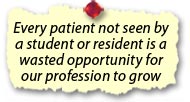|
|
|
Jarrod Shapiro, DPM
Practice Perfect Editor
Assistant Professor,
Dept. of Podiatric Medicine,
Surgery & Biomechanics
College of Podiatric Medicine
Western University of
Health Sciences,
St. Pomona, CA |
Have you ever had one of those days where every patient you see in the office seems to have common everyday problems that after, several years, become stale? I've only been in practice for 7 years now, but I can imagine that for some people – maybe someone in practice for 30 years for example – may become bored with the mundane "bread and butter" pathologies we see. Think of that patient with the verruca plantaris diagnosis or onychomycosis. These aren't the sexiest conditions, and most of us have a basic protocol for treating them, a sort of knee-jerk method. After a while, these become the patients we squeeze in between the "sexier" patients,  maybe the surgical posterior tibial tendon dysfunction or a complex pediatric patient. We're in and out of the room in 5 minutes, looking to move on to the next interesting patient. But don't these patients and their pathology deserve our attention and interest? How do we keep clinical practice fresh? maybe the surgical posterior tibial tendon dysfunction or a complex pediatric patient. We're in and out of the room in 5 minutes, looking to move on to the next interesting patient. But don't these patients and their pathology deserve our attention and interest? How do we keep clinical practice fresh?

I have a few ideas. I know what you're thinking: "When doesn't Shapiro have a few weird ideas?"
Well, hang with me for a few minutes (you've read this far), and maybe I can convince you to find bread and butter as interesting as fillet minion.
First, Be An Educator
Here's my first suggestion – it's time to become a teacher. I'm very happy to say that my clinical days are never boring. As a teacher at one of the podiatry schools, a significant portion of my time is spent in clinical teaching. This means that for almost every patient I see, one of my students will see the patient first. For them, it's all new. They're like little babies learning to walk. Have you ever watched a baby explore their world?  As a parent, I get to watch my children learn about their surroundings, and the many things I take for granted take on a new quality. I start to see old things in a new way. This is also true teaching podiatry students and residents. As a parent, I get to watch my children learn about their surroundings, and the many things I take for granted take on a new quality. I start to see old things in a new way. This is also true teaching podiatry students and residents.
Here's an example. I had a patient the other day with plantar fasciitis. My student saw the patient and presented to me, but failed to provide enough detail. As a result, we had a good conversation about the importance of shoes, activity, and the biomechanics involved with this otherwise run-of-the-mill patient. In private practice, this patient would have been in and out of my office pretty quickly and without a lot of afterthought on my part. Instead, by having a student with me, our patient became an open book for further understanding of several issues pertinent to foot and ankle pathology. My student learned something, and I had a richer human interaction.
Similarly, performing a matricectomy, previously a mundane procedure that I've performed countless times, becomes a new and exciting experience for a student who's never done this before. It's simply more fun. Bread and butter becomes fillet mignon.
 There's another side benefit to becoming a teacher. You're helping podiatry as a whole. By teaching, you are providing increased numbers of clinical experiences to our residents, which will only help with the current residency shortage that everyone is talking about. Every patient not seen by a student or resident is a wasted opportunity for our profession to grow. Contact your nearest podiatry school or podiatric residency to get involved. There's another side benefit to becoming a teacher. You're helping podiatry as a whole. By teaching, you are providing increased numbers of clinical experiences to our residents, which will only help with the current residency shortage that everyone is talking about. Every patient not seen by a student or resident is a wasted opportunity for our profession to grow. Contact your nearest podiatry school or podiatric residency to get involved.
Second, Read the Literature
I know this isn't new, but reading the literature is a great way to make something old something new. Take an old standby like plantar fasciitis. It could be the regular old bread and butter heel pain, but if you read even a small amount of the literature, you'll notice plantar fasciitis isn't as cut and dry as one might expect. Take the plantar fasciitis versus fasciosis debate. The concept that this condition is a chronic degeneration of the plantar fascia rather than an acute inflammatory process is highly interesting with significant treatment ramifications. Reading about this endows the typical with novelty.
How about the use of orthotic therapy for plantar fasciitis? We know as podiatrists that there's a lot at stake behind this question, and reading the research will make us better able to handle this question, while also making an old diagnosis new again. Of course, there are also a lot of facets to this question. For example, take the important cadaver study by Kogler, et al in 1999, in which they found that placing a wedge under the lateral forefoot was most effective in reducing strain on the plantar aponeurosis1 in contradistinction to Root's prescription to place a forefoot varus wedge . Those that accept the findings of this study would have a potentially new method to their orthotic therapy, while also adding interest to a highly routine treatment.
Does surgery excite you? How about a more recent journal article by Fallat and colleagues that retrospectively compared percutaneous fasciotomy versus open plantar fasciotomy and spur excision for plantar fasciitis?2
Regardless of your subject of interest, reading the literature puts a new light on the old and mundane. Remember, no one knows everything about anything. As such, there will always be something new to learn. Add a little garlic to that bread and butter!
Third, Talk to Others
An extension of the reading-the-literature-idea is to go one step beyond and participate in a journal club or discussion group. Most of us recall from residency the ubiquitous journal clubs as part of our education. At Western University we have a journal club two times a month for our students, and we also do a clinical case conference on Tuesday mornings. These are often highly interactive with an interesting discussion about the topic of the day. For the students these activities are educationally-based and sometimes somewhat high stress since they have to perform for their attendings. But for me, as one of their teachers, it's simply an interesting discussion that often teaches me something new about old topics.
To wrap up our discussion, the one suggestion I can make for those who don't have close access to students and residents would be to create your own journal club or discussion group with local colleagues. Better yet, join the larger podiatric community and participate on PRESENT's eTalk. There are many vibrant discussions going on all day about so many different topics. You can even start your own thread. I've personally learned many new things and made new colleagues. Give it try. The more participants we have the better. Bread and butter or fillet mignon. You choose.
Best wishes.

Jarrod Shapiro, DPM
PRESENT Practice Perfect Editor
[email protected]
References:
- Kogler G, et al. JBJS 1999; 81-A(10): 1403-1413.
- Fallat L, et al. JFAS 2013; epublished ahead of print.
Get a steady stream of all the NEW PRESENT Podiatry
eLearning by becoming our Face book Fan.
Effective eL earning and a Colleague Network await you. |
 |
This ezine was made possible through the support of our sponsors: |
|